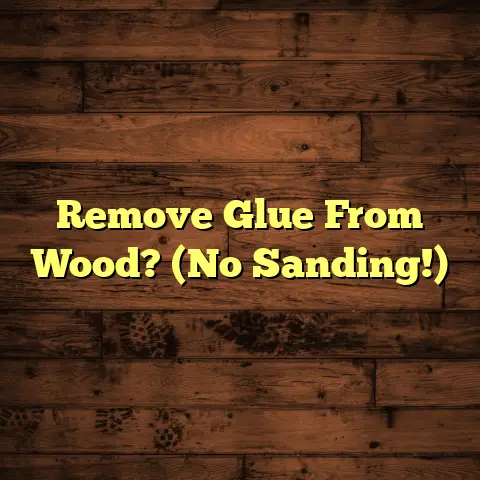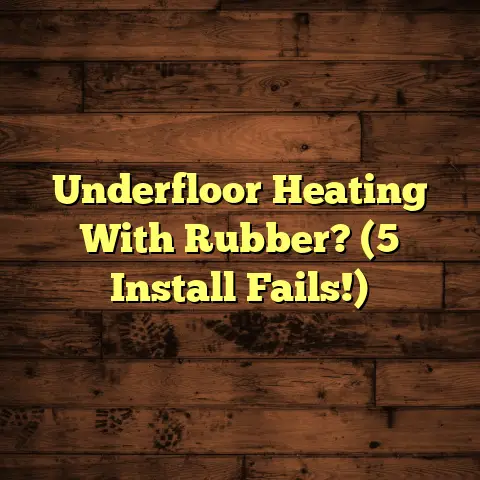Remove Laminate From The Middle (2 Install Hacks!)
And let me tell you, dealing with damaged laminate in the middle of a room?
That’s a challenge many homeowners face.
Especially those with active families.
Whether it’s a rogue water spill that warped a few planks or just plain wear and tear, replacing those center pieces can feel like a full-blown renovation.
But fear not!
I’m here to share two install hacks that’ll make this job much easier, and even…dare I say…fun!
We’ll keep the disruption to your family life to a minimum.
Let’s dive in!
Section 1: Understanding Laminate Flooring
1.1 What is Laminate Flooring?
Laminate flooring, in a nutshell, is a synthetic flooring option designed to mimic the look of hardwood, tile, or stone.
It’s made up of several layers:
-
A wear layer: This top layer is a transparent coating that protects against scratches, stains, and fading.
-
A decorative layer: This is a high-resolution printed image that gives the laminate its realistic appearance.
-
A core layer: This is usually made of high-density fiberboard (HDF) or medium-density fiberboard (MDF), providing stability and durability.
-
A backing layer: This bottom layer provides moisture resistance and helps prevent warping.
For families, laminate is a winner because it’s:
-
Durable: It can withstand the daily grind of kids, pets, and foot traffic.
-
Easy to Clean: Spills and messes are a breeze to wipe up.
-
Affordable: It’s often more budget-friendly than hardwood or tile.
According to Statista, laminate flooring accounted for approximately 8% of the total flooring market share in the United States in 2023, showcasing its continued popularity.
https://www.statista.com/statistics/276486/market-share-of-flooring-in-the-us-by-material/
1.2 Common Reasons for Removal
So, why would you need to remove laminate from the middle of a room?
Here are a few common culprits:
-
Wear and Tear: High-traffic areas can show scratches, dents, and fading over time.
-
Water Damage: Spills that aren’t cleaned up quickly can seep into the seams and cause swelling or warping.
-
Style Changes: Maybe you’re just tired of the look and want to update your space.
-
Accidents: A dropped heavy object can crack or damage a plank.
I’ve seen families struggle with warped laminate after a plumbing leak, or deal with unsightly scratches from overzealous pets.
These issues not only affect the aesthetics of your home but can also impact your family’s daily life.
Imagine tripping over a warped plank or constantly worrying about spills ruining your floor.
Not fun, right?
Section 2: Preparing for the Removal Process
Okay, so you’ve identified the problem and you’re ready to tackle it.
Before you start ripping up planks, let’s get prepared.
2.1 Gathering Necessary Tools and Materials
Here’s a list of tools you’ll likely need:
Laminate Cutter (Optional): For making precise cuts.
A circular saw with a fine-tooth blade can also work.-
Pry Bar: For gently lifting the planks.
-
Utility Knife: For scoring and cutting adhesive.
-
Hammer: For tapping the pry bar.
-
Safety Goggles: Protect your eyes from debris.
-
Gloves: Protect your hands.
-
Measuring Tape: For accurate measurements.
-
Pencil: For marking cut lines.
-
Vacuum Cleaner: For cleaning up dust and debris.
-
Underlayment (If Needed): To replace damaged underlayment.
-
Adhesive (If Needed): For securing new planks.
I always recommend having a bit of extra laminate flooring on hand, ideally from the original installation, to ensure a perfect match.
2.2 Creating a Family-Friendly Environment
This is crucial, especially if you have kids or pets.
Here’s how to minimize disruption and keep everyone safe:
-
Clear the Area: Remove all furniture, rugs, and other items from the work area.
-
Designate a Safe Zone: Set up a temporary play area or living space in another room where kids and pets can be safely out of the way.
-
Communicate: Explain to your kids what you’re doing and why.
Make sure they understand the importance of staying out of the work area.
-
Safety First: Keep tools out of reach and clean up any debris immediately.
I remember one family I worked with turned the project into a “fort-building” day.
They created a cozy space in the living room with blankets and pillows, making the disruption feel like an adventure.
Genius!
Section 3: Install Hack #1 – The Cutting Technique
3.1 Overview of the Cutting Technique
This hack is perfect for when you need to remove a section of laminate in the middle of the room without disturbing the surrounding planks.
The key is to make precise cuts that allow you to remove the damaged section without damaging the tongue-and-groove edges of the adjacent planks.
3.2 Step-by-Step Instructions
Measure and Mark: Carefully measure the area you need to remove.
Use a pencil and straight edge to mark the cut lines on the damaged planks.Make sure your cut lines are slightly inside the edges of the surrounding planks.
This will give you room to maneuver the damaged section out.
-
Score the Surface: Use a utility knife to score along the cut lines.
This will help prevent chipping and splintering when you make the actual cuts.
-
Make the Cuts: Using a laminate cutter or circular saw with a fine-tooth blade, carefully cut along the scored lines.
Safety Tip: Wear safety goggles and gloves during this step.
Take your time and make sure the cuts are straight and clean.
-
Remove the Section: Once you’ve made the cuts, use a pry bar to gently lift the cut section.
You may need to use a hammer to tap the pry bar under the planks.
Be careful not to damage the surrounding planks.
-
Clean Up: Vacuum up any dust and debris.
3.3 Family Involvement
While the cutting itself should be done by an adult, there are plenty of ways to involve the family:
-
Measuring and Marking: Let older kids help with measuring and marking the cut lines (under supervision, of course).
-
Cleaning Up: Even young children can help with sweeping and vacuuming.
-
Moral Support: Sometimes, just having family members nearby offering encouragement can make the job feel less daunting.
I’ve seen families turn this into a learning experience, teaching kids about measurement, tools, and home improvement.
It’s a great way to bond and create lasting memories.
Section 4: Install Hack #2 – The Pull-Up Method
4.1 Overview of the Pull-Up Method
This method is ideal for when you need to remove a larger area of laminate flooring, or when the planks are loosely connected.
The goal is to gently pull up the planks from the center of the room, working your way outwards.
4.2 Step-by-Step Instructions
-
Identify the Starting Point: Choose a plank in the center of the area you want to remove.
Look for a plank that seems slightly loose or damaged.
-
Loosen the Plank: Use a pry bar to gently lift the edge of the plank.
You may need to use a hammer to tap the pry bar under the plank.
Be careful not to damage the tongue-and-groove edges.
-
Pull Up the Plank: Once you’ve loosened the plank, carefully pull it up.
If it’s stuck, try wiggling it back and forth to loosen the connection.
-
Continue Removing Planks: Work your way outwards from the starting point, pulling up the surrounding planks one by one.
Pay attention to the direction of the tongue-and-groove connections.
You may need to use a utility knife to cut the adhesive if the planks are glued down.
-
Clean Up: Vacuum up any dust and debris.
4.3 Family Safety and Engagement
-
Designate a “No-Go Zone”: Keep children and pets away from the area where you’re pulling up planks.
Loose planks can be a tripping hazard.
-
Provide Entertainment: Set up a movie or game in the designated safe zone to keep younger family members entertained.
-
Offer Small Tasks: Let older children help with sorting and stacking the removed planks.
I once saw a family create a “laminate plank obstacle course” in their backyard with the removed planks (after ensuring they were safe, of course!).
It was a fun way to recycle the materials and keep the kids active.
Section 5: Post-Removal Considerations
Alright, you’ve successfully removed the damaged laminate.
Now what?
5.1 Assessing the Subfloor
Before you install new flooring, it’s crucial to check the condition of the subfloor.
Here’s what to look for:
-
Moisture: Check for signs of water damage, such as stains, mold, or mildew.
Use a moisture meter to check the moisture level of the subfloor.
Ideally, it should be below 12%.
-
Levelness: Use a level to check for any dips or bumps in the subfloor.
Unevenness can cause problems with the new flooring.
-
Damage: Look for cracks, holes, or other damage.
If you find any issues, you’ll need to repair them before installing new flooring.
This might involve patching holes, leveling the surface, or addressing moisture problems.
I’ve seen families discover hidden water damage under their laminate flooring, which required professional remediation.
It’s always better to be safe than sorry!
5.2 Preparing for New Flooring Installation
Once you’ve assessed and repaired the subfloor, it’s time to prepare for the new flooring installation.
Here are a few steps to take:
-
Clean the Subfloor: Vacuum and sweep the subfloor thoroughly to remove any dust, debris, or adhesive residue.
-
Install Underlayment (If Needed): If you’re installing laminate or another floating floor, you’ll need to install underlayment.
This provides cushioning, sound insulation, and moisture protection.
-
Acclimate the New Flooring: Allow the new flooring to acclimate to the room’s temperature and humidity for at least 48 hours before installation.
-
Plan the Layout: Plan the layout of the new flooring to minimize waste and ensure a visually appealing result.
Involving the family in choosing the new flooring can be a fun and rewarding experience.
Consider their preferences, lifestyle, and budget when making your decision.
Maybe the kids want a soft carpet in their bedrooms, while the adults prefer a durable tile in the kitchen.
Compromise and collaboration are key!
Conclusion: The Family-Focused Approach to Home Improvement
Removing laminate flooring from the middle of a room might seem like a daunting task, but with the right techniques and a family-oriented approach, it can become an engaging project.
By employing the cutting technique and the pull-up method, families can efficiently address flooring issues while spending quality time together.
The experience not only improves the home but strengthens family bonds, creating lasting memories as they enhance their living space.
I’ve seen firsthand how these projects can bring families closer, fostering teamwork, communication, and a sense of accomplishment.
So, grab your tools, gather your family, and get ready to transform your home!
You got this!





